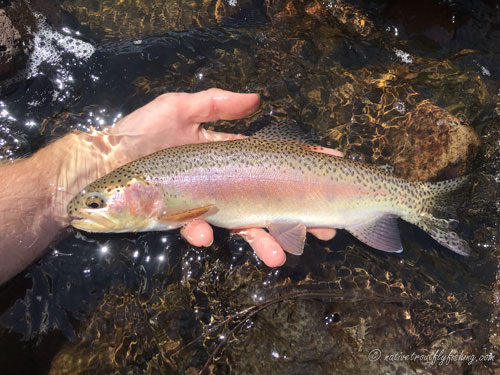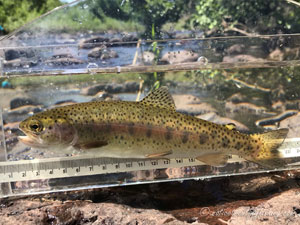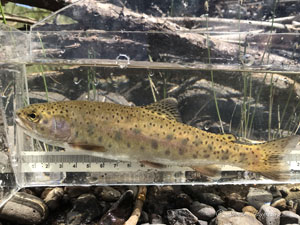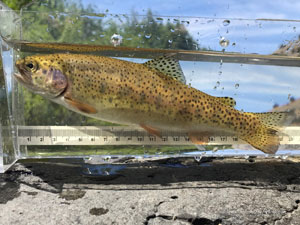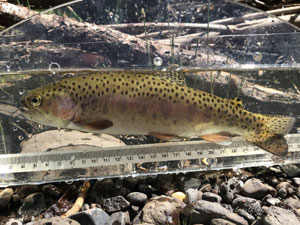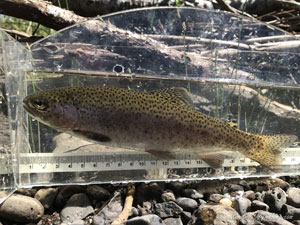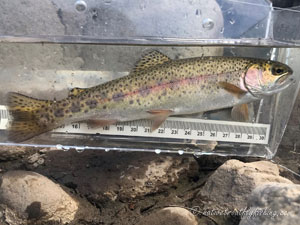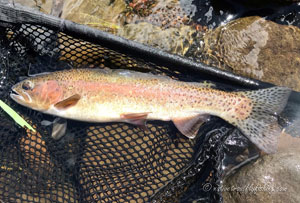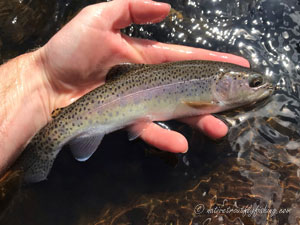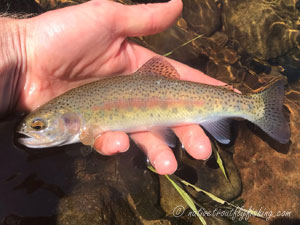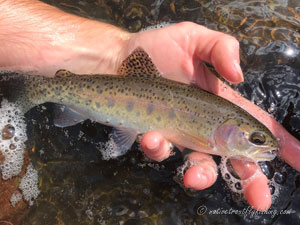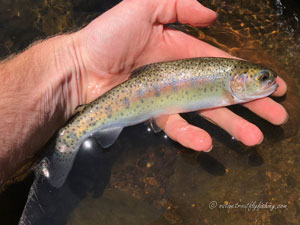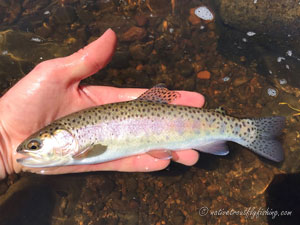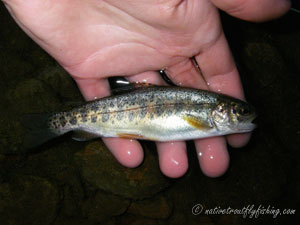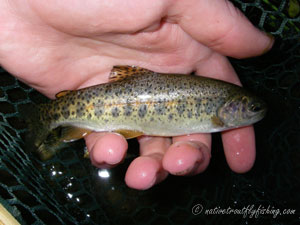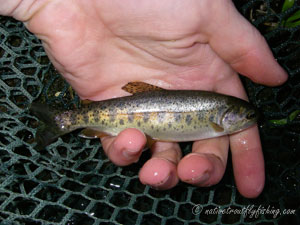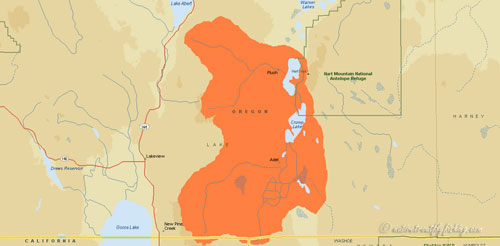Warner Lakes Redband
Oncorhynchus mykiss stonei
A Warner Lakes redband from a stream in Southern Oregon.
Introduction
The Warner Valley Redband Trout are endemic to the Warner Valley of Southern Oregon and Northeastern California. Both taxonomic and genetics studies indicate that Warner Basin Redbands are most closely related to Goose Lake Redbands (Behnke 1992, Currens et al. 2009), with one population in the Warner Basin being genetically indistinguishable from Goose Lake Redbands (DeHaan et al. 2015). A recent study has shown an even closer relationship between Warner Valley Redbands and the Redbands in the Pit River drainage and showed that Warner Valley Redband Trout are closely related to the Redbands native to the nearby Surprise Valley (Campbell et al. 2023).
Life History Information
The Warner Valley is composed of a series of lakes, marshes and sloughs that are vestiges of its large Pleistocene lake. In most years some of these bodies of water still provide suitable habitat for trout and as such an adfluvial life history type has been maintained by these Redbands, as well as stream resident and possibly fluvial populations in the streams flowing into the valley. Today populations of Warner Valley Redbands are found in three drainages (Twelvemile, Deep and Twentymile creeks) flowing off the Warner Mountains, as well as in Crump, Pelican and Hart Lakes and Greaser Reservoir (ODFW 2005). The adfluvial life history type is dependent on the basin receiving enough precipitation and may not be possible during drought years when the lakes and lower reaches of the streams dry up. However, the trout quickly re-colonize this habitat when it becomes available again during wet years. During 1992 the many of the large lakes in the basin dried up, but redbands were found in them during years with sufficient water both before and after the drought year (USFWS 1998). Even when this habitat is available, it appears that abundance in the lakes is low, and the majority of the fish express a stream resident life history (ODFW 2005).
Status
Like the other Redbands of the northern Great Basin, the Warner Lakes Redband were petitioned to be listed under the Endangered Species Act (ESA) in 1997, but it was not found to be warranted (USFWS 1997). However, two other endemic species the Foskett Speckled Dace and the Warner Sucker are currently listed as threatened under the ESA (Williams et al. 1990), with the Warner Dace sharing its habitat with Warner Redband Trout. The Oregon Department of Fish and Wildlife (ODFW) currently considers these fish to be at risk of extinction, with a recent population estimate for the basin indicating that there were approximately 171,715 age-1+ Redbands in the valley (Dambacher et al. 2009). Two of the major threats to Warner Valley Redbands are habitat degradation and the introduction of non-native fish (ODFW 2005). Hatchery trout were stocked in the basin's streams until 1989, and it appears that at least some hybridization has occurred (Behnke 1992), but that the Warner Valley Redband is still genetically distinct from hatchery rainbow trout (DeHaan et al. 2015). Beyond nonnative trout, several species of warm water fish including crappie, bass and catfish have been stocked in the basin's lakes and are believed to compete with and prey on adfluvial Redbands. Habitat degradation has had a major impact on these fish and some of the impacts stem from logging, agriculture, poor grazing practices and mining (USFWS 1998). Stream alterations for agricultural purposes have been a major source of habitat degradation, as the lower reaches of the streams have been channelized and water diversions for irrigation have been installed. These diversions are believed to suppress the abundance of Redbands with the adfluvial life history and Honey Creek alone there are eight diversions (ODFW 2005). The lower section Twentymile Creek is currently heavily impacted by agricultural uses and is also cut off from Crump Lake as well as Deep Creek, preventing any connections to other populations (Gerstung 2007).
Description
The coloration of these fish is olive or bronze on the back and transitions to a yellowish color across the body. As their namesake suggests, these Redbands have a brick red stripe along their lateral line, and the same coloration on their gill plates. Purplish colored elliptical shaped parr marks are often retained into maturity in stream resident fish but fade away in adfluvial or larger stream resident individuals. These lake dwelling trout also generally will have a more silvery coloration than their stream resident counterparts. The spotting pattern consists of small round or irregular shaped spots that are profusely distributed on the caudal and dorsal fins above the lateral but may be absent below it on some individuals. The caudal fin is forked, dorsal fin may be tipped with either white or orange, while anal, pectoral and pelvic fins are both tipped with white.
Stream Resident Form
Click on images to view a larger picture
Native Range
A map of the native range of the Warner Lakes redband trout. Data Sources: Behnke (2002) and ODFW (2005).
References
Behnke, R. J. 1992. Native trout of western North America. American Fisheries Society Monograph 6. American Fisheries Society, Bethesda, Maryland.
Behnke, R.J. 2007. Redband trout of the Northern Great Basin. Pages 1–9 in R. K. Schroeder and J.D. Hall, editors. Redband trout: resilience and challenge in a changing landscape. Oregon Chapter, American Fisheries Society, Corvallis.
Bowers, W., Smith, R., Messmer, R., Edwards, C., and Perkins, R. 1999. Conservation status of Oregon Basin Redband Trout, Oregon Dept. of Fish and Wildlife, Hines, OR.
Campbell, M.A., E. Habibi, G. Aubringer, M. Stephens, J. Rodzen, K.W. Conway, A.J. Finger. 2023. Molecular systematics of redband trout from genome-wide DNA sequencing substantiates the description of a new taxon (Salmonidae: Oncorhynchus mykiss calisulat) from the McCloud River. Zootaxa 5254 (1): 000-029. https://doi.org/10.11646/zootaxa.5254.1.1
Currens, K.P., C.B. Schreck and H.W. Li. 2009. Evolutionary ecology of redband trout. Transactions of the American Fisheries Society 138: 797–817.ODFW. 2005. Oregon native fish status report. Oregon Dept. of Fish and Wildlife, Salem, OR.
Dambacher, J.M., K.K. Jones and D.P. Larsen. 2009. Landscape-level sampling for status review of Great Basin Redband Trout. North American Journal of Fisheries Management 29:1091–1105.
DeHaan, P., J. Von Bargen, M. Meeuwig and S. Clements. 2015. Great Basin redband trout genetic status assessment. United States Fish and Wildlife Service. Longview, Washington.
Gerstung, E. 2007. Status and management of three groups of redband trout in northeastern California. Pages 113–122 in R. K. Schroeder and J.D. Hall, editors. Redband trout: resilience and challenge in a changing landscape. Oregon Chapter, American Fisheries Society, Corvallis.
ODFW. 2005. Oregon native fish status report. Oregon Dept. of Fish and Wildlife, Salem, OR.
Williams, J.E., M.A. Stern, A.V. Munhall and G.A. Anderson. 1990. Conservation status of threatened fishes in Warner Basin, Oregon. Great Basin Naturalist 50(3): 243-248.
U.S. Fish and Wildlife Service (USFWS). 1997. A petition for rules to list great basin redband trout (Oncorhynchus mykiss ssp) as threatened or endangered under the Endangered Species Act. Oregon Natural Desert Association, Portland, OR.
U.S. Fish and Wildlife Service. 1998. Recovery plan for the native fishes of the Warner basin and Alkali subbasin. Portland, Oregon. 86 pp.
Contact
Feel free to contact me if you have any questions or comments
Warner Lakes Redband Trout Links
California Department of Fish and Wildlife - Angling for Warner Lakes Redband Trout
Oregon Department of Fish and Wildlife - Redband Trout
Warner Wetlands - Bureau of Land Management
Modoc National Forest - Warner Mountains District
Western Native Trout Initiative - Redband Trout
Native Trout Links
Truchas Mexicanas' - Native Trout of Mexico
Balkan Trout Restoration Group
Trout and Seasons of the Mountain Village - About Japanese Trout
Western Native Trout Challenge
California Heritage Trout Challenge
Fly Fishing Blogs
Dave B's Blog: Fly Fishing for Native Trout
The Search for Native Salmonids
Conservation Links
Western Native Trout Initiative
Fly Fishing Links
Fishing Art Links
Americanfishes.com - Joseph R. Tomelleri
